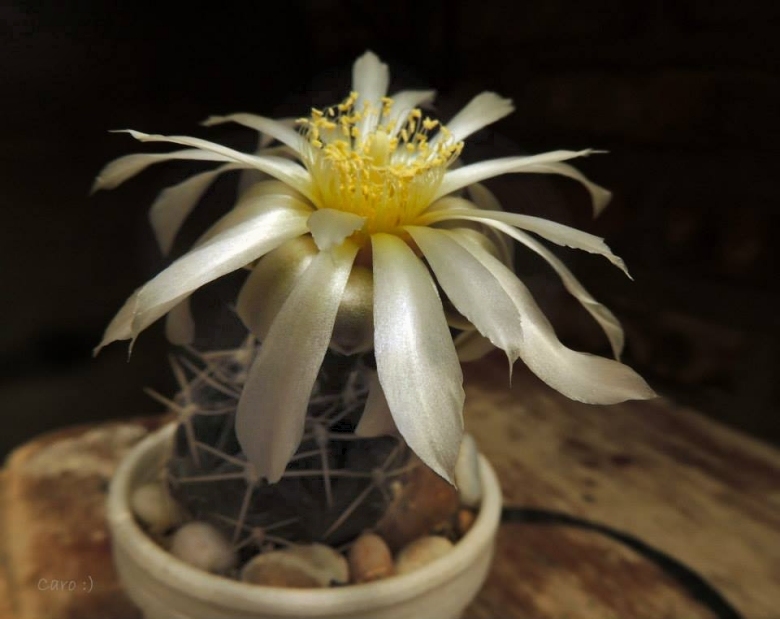Accepted Scientific Name: Gymnocalycium marsoneri Y.Itô
Explan. Diagr. Austroechinocactinae 293 (1957) Y.Itô

Gymnocalycium hamatum Photo by: Carolina González
Origin and Habitat: Gymnocalycium hamatumSN|13350]]SN|13350]] was discovered by Friedrich Ritter near Palos Blancos, Tarija, Bolivia in 1958. Up to now this species has only been found near its type habitat at Palos Blancos.
Altitude range: 730-870 metres above seal level.
Synonyms:
See all synonyms of Gymnocalycium marsoneri
back
Accepted name in llifle Database:Gymnocalycium marsoneri Y.ItôExplan. Diagr. Austroechinocactinae 293 (1957)Synonymy: 12
Accepted name in llifle Database:Gymnocalycium marsoneri subs. matoense (Buining & Bredero) P.J.Braun & EstevesSucculenta (Netherlands) 74: 131. 1995Synonymy: 4
Cultivars
(1):
back
Description: Gymnocalycium hamatumSN|13338]]SN|13350]] (firstly described as by Friedrich Ritter in in "Kakteen in Südamerika" vol 2, 663-664, 1980) is a local or morphological form of Gymnocalycium marsoneriSN|13350]]SN|13338]]. It has an olive green, tuberculate body. The pale coloured spines are all radial, standing out from the body, straight but slightly hooked at the tip. However the distinguishing characteristics of Gymnocalycium hamatumSN|13338]]SN|13350]], appear to fall within the natural variation of Gymnocalycium marsoneriSN|13350]]SN|13338]] and it should be synonymized with the latter.
Note: Gymnocalycium hamatumSN|13338]]SN|13350]] has been made synonymous to Gymnocalycium marsoneriSN|13350]]SN|13338]] subs. megatae by G. Charles without specifically justify that choice.
Stem: Usually solitary (not clustering), globular flattened, 6-18 cm in diameter grey-green, olive green to coppery brown.
Ribs: 9-16 with blunt tubercles.
Areoles: 5-8 mm long, 3 mm wide, 10-18 mm apart, with a cream to white wool.
Spines: All radial, 5 to 9, 15-20 (or more) mm long mostly creamy-white or light yellowish brown, some-times reddish-brown, stiff, straight but slightly hooked at the tip, hence the specific name (Latin adjective “hamatus”, “hamata”, “hamatum” = hooked).
Flowers:Produced around the stems side, away from the apex. Large, about 5 cm long, white with a pink middle stripe
Fruits Red, with a blue bloom, fusiform, 25-30 mm long , 15-20 mm wide. Pulp pinkish.
Bibliography: Major references and further lectures
1) Terry Smale, Cactus and Succulent Society of Great Britain “Notes on the 1977 seed distribution” Cactus and Succulent Journal of Great Britain”, Volumes 39-43 page 17, 1977.
2) Gymnocalycium hamatum F. Ritter <http://www.richtstatt.de> Web. 9 May. 2015.
3) Demaio, P. H., M. H. J. Barfuss, W. Till & J. O. Chiapella. 2010. “Phylogenetic relationships and infrageneric classification of the genus Gymnocalycium: insights from molecular data. Gymnocalycium” 2010: 925–946.
4) Navarro Sánchez, G. 1996. “Catálago ecológico preliminar de las cactáceas de Bolivia.” Lazaroa 17: 33–84.
5) Jørgensen, P. M., M. H. Nee & S. G. Beck. (eds.) 2014. “Cat. Pl. Vasc. Bolivia”, Monogr. Syst. Bot. Missouri Bot. Gard. 127(1–2): i–viii, 1–1744. Missouri Botanical Garden Press, St. Louis.
6) Friedrich Ritter “Kakteen in Südamerika: Ergebnisse meiner 20jährigen Feldforschungen” volume 2, 1980
Cultivation and Propagation: Gymnocalycium hamatumSN|13350]]SN|13350]] is a summer grower species that is easy to cultivate.
Growth rate: It is a relatively rapidly growing and easily flowering species that will make clumps given the best conditions.
Soils: It likes very porous standard cactus mix soil. Prefer a low pH compost, avoid substrata rich in limestone; otherwise growth will stop altogether.
Repotting: This plant needs plenty of space for its roots, repotting should be done every other year or when the it has outgrown its pot. Use pot with good drainage.
Watering: Needs moderate to copious waterings in summer, but do not overwater (Rot prone), keep dry in winter at a minimum temperature of 0°C.
Fertilization: Feed with a high potassium fertilizer in summer.
Hardiness: Reputedly resistant to frost if kept on the dry side prior to, and during, cold weather (hardy to -5 C ° C, or less for short periods).
Exposition: The plant tolerates extremely bright situations but enjoys filtered sunlight or afternoon shade, inside it needs bright light, and some direct sun. Tends to bronze in strong light, which encourages flowering and heavy spine production, but is likely to suffer from sun scorch or stunted growth if over exposed to direct sunlight during the hottest part of the day in summer.
Uses: It is an excellent plant for container growing. It always looks good and stays small. It look fine in a cold greenhouse and frame or outdoor in a rockery.
Pests & diseases: It may be attractive to a variety of insects, but plants in good condition should be nearly pest-free, particularly if they are grown in a mineral potting-mix, with good exposure and ventilation. Nonetheless, there are several pests to watch for:
- Red spiders: Red spiders may be effectively rubbed up by watering the plants from above.
- Mealy bugs: Mealy bugs occasionally develop aerial into the new growth among the wool with disfiguring results, but the worst types develop underground on the roots and are invisible except by their effects.
- Scales: Scales are rarely a problem.
- Rot: This species is particularly easy and accommodating, seldom suffer of cryptogamic diseases. Rot it is only a minor problem with gymnocalyciums if the plants are watered and “aired” correctly. If they are not, fungicides won't help all that much.
Propagation: Division, direct sow after last frost. Seeds germinate in 7-14 days at 21-27° C in spring, remove gradually the glass cover as soon the plants will be well rooted (ca 1-2 weeks) and keep ventilated, no full sun for young plants! To make a cutting twist off a branch and permit it to dry out a couple of weeks, lay it on the soil and insert the stem end partially into the soil. Try to keep the cutting somewhat upright so that the roots are able to grow downward.











